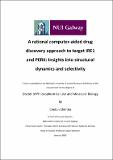| dc.contributor.author | Chintha, Chetan | |
| dc.date.accessioned | 2020-05-18T12:38:45Z | |
| dc.date.issued | 2020-05-18 | |
| dc.identifier.uri | http://hdl.handle.net/10379/15977 | |
| dc.description.abstract | Cells constantly monitor the number of misfolded proteins they accumulate. The
accumulation of misfolded proteins in the endoplasmic reticulum (ER) triggers an
evolutionarily conserved signaling pathway called the unfolded protein response
(UPR). Inositol-requiring enzyme 1 (IRE1), PKR-like endoplasmic reticulum kinase
(PERK), and activating transcription factor 6 (ATF6) are the main UPR signal
transducers. IRE1α and PERK were characterized using a chemical biology approach. Primarily,
computational analysis of druggable sites of IRE1α and PERK was carried out. We
performed docking studies to understand the selectivity of PERK kinase inhibitors.
Additionally, KIT was identified as a common non-specific target of UPR kinase
inhibitors kinase inhibiting RNase attenuator 6 (KIRA6) and GSK2606414 (GSK414).
We analyzed the IRE1α RNase pocket for the suitability of structure-based drug
screening. Further, we looked at how an IRE1α kinase inhibitor impacted the
different dimer forms using in silico methods. Finally, virtual screening was
performed for the IRE1α kinase active site. Novel lead compound NUIG10 was
identified and validated in in vitro direct binding assay and RNase activity assay.
Collectively, we highlighted various aspects of IRE1α and PERK drug discovery. In
particular, our approaches provided structural insights into hit-identification and hit-to-
lead optimization of novel IRE1 inhibitors. | en_IE |
| dc.publisher | NUI Galway | |
| dc.rights | Attribution-NonCommercial-NoDerivs 3.0 Ireland | |
| dc.rights.uri | https://creativecommons.org/licenses/by-nc-nd/3.0/ie/ | |
| dc.subject | endoplasmic reticulum stress | en_IE |
| dc.subject | unfolded protein response | en_IE |
| dc.subject | Science | en_IE |
| dc.subject | Natural Science | en_IE |
| dc.subject | Cellular and Molecular Biology | en_IE |
| dc.title | A rational computer-aided drug discovery approach to target IRE1 and PERK: Insights into structural dynamics and selectivity | en_IE |
| dc.type | Thesis | en |
| dc.contributor.funder | Horizon 2020 | en_IE |
| dc.local.note | Cells in our body constantly monitor and adapt to the number of misfolded proteins by a pathway called ‘unfolded protein response’ (UPR). The current work is focused on a combination of computational and biochemical approaches for the discovery of new kinase inhibitors of UPR proteins (IRE1 and PERK), dynamic regulation, and selectivity. | en_IE |
| dc.description.embargo | 2024-05-16 | |
| dc.local.final | Yes | en_IE |
| dcterms.project | info:eu-repo/grantAgreement/EC/H2020::MSCA-ITN-ETN/675448/EU/Endoplasmic Reticulum Stress in Health and Disease/TRAIN-ERS | en_IE |
| nui.item.downloads | 0 | |


